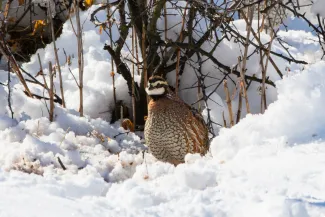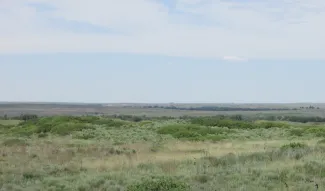
Shrub cover can provide both predator and thermal cover for wildlife, including the iconic northern bobwhite.
Many believe northern bobwhite quail to be grassland birds and while the birds do indeed occur in open rangeland habitats, research has shown the species does best when shrub thickets of adequate size and structure dot the landscape. In fact, bobwhites may be entirely absent from a property solely because suitable shrubby cover is nowhere to be found. The question is are some shrubs better than others? Even more, what should a suitable shrub thicket look like for quail and how many should there be?
Across the state, some of the best shrub thickets for quail are composed of sumacs and plums, especially smooth sumac, winged sumac, fragrant sumac, and sand plum. Other important shrubs include shinnery oak mottes or thickets, and on a smaller structural scale, sand sagebrush, both western Oklahoma species. Eastern Oklahoma is largely forested, so shrub-like cover can be served by shrub thickets or by other means like young stands of hardwood or pine regeneration, trees with limbs to ground level, or through hinge cutting. However, whether east of Interstate-35 or west, managing for a mix of shrub types and shrub-like cover is the best strategy as some shrub cover offers better thermal and predator protection during the summer months with others better in winter.
Another important consideration when it comes to managing shrub thickets for quail are the size and structure of each thicket. Though cover requirements can vary, bobwhites prefer low-growing woody cover over thickets with open canopies infested with tall trees. Prime shrub thickets regularly used as covey “headquarters” are those that are three to six feet in height, have a dense overhead canopy of cover (60-80% closed), and are no smaller than 10 feet in diameter. However, research has shown that thickets between 30 and 65 feet in diameter are best.
Shrub thicket placement is also important, especially when the presence of quail is desired across an entire property or habitat type. Generally, a scattered look is best, with thickets about 100 feet apart being optimum. Having 30% of the habitat providing suitable shrub cover is important. However, quail rarely venture far from good protective woody cover, thus the reason for the scattered shrub look. Having good to excellent thickets every “softball’s throw away” allow quail to venture further to meet their daily and yearly needs, and this can help support more quail coveys, especially if other habitat components such as nesting, brood rearing, and foraging habitats are of high quality.

Scattered shrub thicket cover is optimum, providing greater opportunities for quail to venture out and expand to meet their daily and yearly needs.

Sumac thickets offer excellent thermal and predator cover, especially during the growing season.
So, with shrub cover of such importance to quail, managing for suitable shrub cover should be a goal for all land managers wishing to hear their call. For properties lacking suitable shrub cover it may be as simple as allowing small shrubs to grow and thickets to develop and expand. Mowing and spraying should be avoided where thickets are needed and/or desired. Heavy grazing can also limit the growth and suitability of shrub thickets, so this too should be monitored. Nearly all shrubs are fire tolerant and some benefit from fire, so prescribed burning isn’t generally a threat when it comes to shrub management. However, occasionally protecting select thickets from fire may be warranted if suitable thickets are in short supply, especially those that are known covey headquarters. Still, thickets can be overtaken by trees, especially eastern red cedar, and fire is a good tool to keep this in check.
Planting can also be an option on some properties. Sand plum and sumac species can be purchased from some nurseries in bare root bundles and planted in thickets using landscape fabric or thick mulch to lessen the weed competition and retain moisture. As a guide, it takes about 100 seedlings to produce a thicket of “ideal” size for quail, with each seedling planted about four feet apart throughout a 30-foot by 50-foot grid-like pattern. Some planting mortality will occur but surviving shrubs will expand through growth and root offshoots. Protecting these recently planted thickets from fire is a good rule, at least until their root systems are well established, which is often evident by their above ground growth.
In short, shrub cover is critical for quail, but shrubs also provide valuable food and cover for a large variety of wildlife. Combining shrub management with other quail-friendly tools like prescribed burning, strategic grazing, disking, and, if needed, prairie restoration is a good way to help bring back the frequent call of these iconic Oklahoma birds.